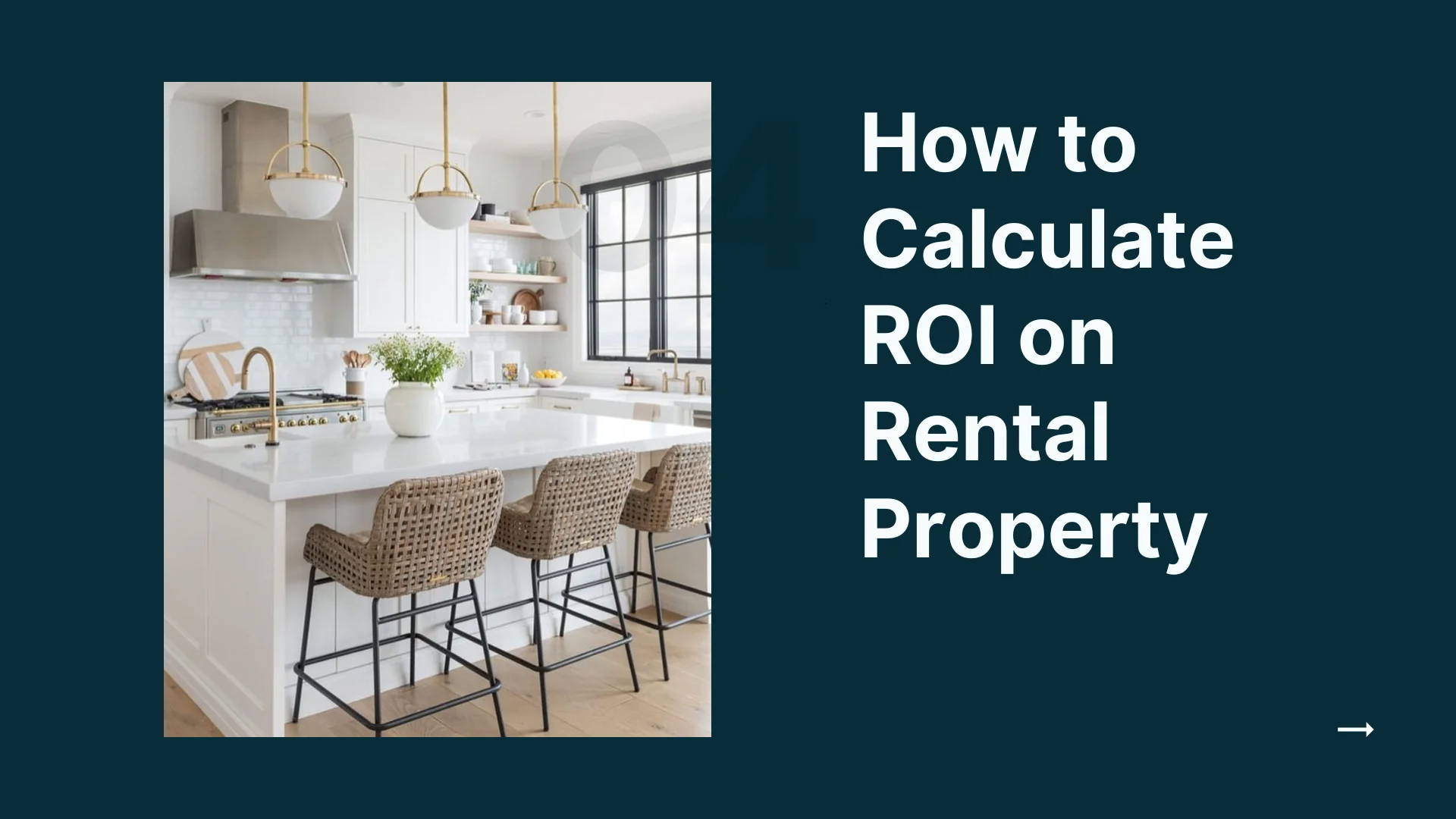When analyzing a rental property investment, you need to understand whether it will generate income and, if so, whether its annual income justifies the cash you invested in the endeavor. A simple way to do this is to use the ROI calculation, which identifies whether you’ll be making a good rental income or barely breaking even when you consider the property’s purchase price.
What does ROI mean?
ROI stands for return on investment and refers to a property’s profitability. In short, you compare a real estate investment’s rental income to its overall cost to determine whether the property generates enough income to justify the purchase price.
Real estate investors use this ratio to compare rental property investments based on the potential income compared to the initial investment. It helps them steer clear of commercial properties that will be a money sink and find investment properties that will generate a healthy passive income.
What does ROI mean?
Identifying a property’s ROI is quite simple — divide the annual returns by the cost of investment. The overall formula looks like this:
Return on Investment = Annual Returns / Cost of Investment
The annual return is your annual rental income from the property minus your annual operating expenses, such as mortgage payments, property management fees, repair and maintenance costs, property taxes, and insurance.
You’ll then divide this by what you paid upfront, which includes the down payment and any repair costs before you started renting the investment property.
Let’s look at a real-world example of calculating ROI, starting with the annual returns. Your annual rental income is $15,000, while your annual operating costs are $8,000. This includes property taxes, monthly mortgage payments, property management fees, and maintenance costs. This means your net profit for the year was $7,000.
Your upfront payment was $48,000, which included a down payment, closing costs, and repairs.
Now, we divide $7,000 by $48,000 to get 0.1458. Multiplied by 100, this gives you a total return on investment (ROI) of 14.58%, which is very admirable.
Other Ways to Calculate ROI on Rental Properties
Aside from ROI, there are other ways to ascertain rental property profitability. Most real estate investors will use a blend of different calculations to monitor their real estate investments and keep track of their monthly cash flow, with the most popular being the following.
Net Operating Income (NOI)
Net operating income identifies the potential rental income of a real estate purchase once all direct operating expenses have been accounted for. The formula takes a look at the rental income minus the operating expenses, and it looks like this:
Net Operating Income = Total Rental Income − Direct Operating Expenses
Your annual rental income includes the obvious, such as the monthly rent, but it also considers other income streams from residential properties, such as parking fees, coin-operated laundry, and vending machines.
Direct operating expenses include expenses directly associated with managing rental property — repairs, property management company fees, utilities, insurance, legal fees, and property taxes. You’ll add all of these together and subtract them from your total net income, which will give you your NOI.
Operating expenses don’t take your mortgage payments, debt service payments, capital expenditures, depreciation, and income taxes into account.
Cash-on-Cash Return
Also called cash yield, cash-on-cash return offers a more precise analysis of the return on your rental property. Generally, it is used by investors who are already renting properties but want to assess their profit margin and identify how they can improve their income. The formula is as follows:
Cash-on-Cash Return = Annual Pre-Tax Cash Flow / Total Cash Invested in the Property
As with calculating ROI, you only consider what you invested in the residential property rather than its overall property value. You’ll identify your cash flow by subtracting all of your expenses from your total rental income, then divide this by your total upfront investment to get a percentage.
Annual Cash Flow
Another simple formula for assessing the profitability of a rental property investment is the annual cash flow. It subtracts your total expenses from your total rental income to identify how much money is flowing into the rental property versus how much is exiting. The formula is as follows:
Annual Cash Flow = Total Annual Income − Total Annual Expenses
Annual cash flow doesn’t show how much money is left in your pocket. Rather, it shows how much money your rental property generates and how it circulates.
Cap Rate
Capitalization rate compares your net operating income to the value of the rental property to see how much income you’re making based on the current real estate market. The formula is:
Cap Rate = Net Operating Income / Current Property Value
The benefit of the capitalization rate is that it helps you assess whether the money borrowed to purchase the property is worth the ongoing costs in the current market. This helps you see whether you should sell a property, increase rental income to boost the cap rate or add a new investment property to your real estate portfolio.
Gross Rent Multiplier (GRM)
Almost like the reverse of the cap rate, the gross rent multiplier divides the mortgage value by the annual gross income in order to see how long it would take the rental property to pay itself off. The formula looks like this:
Gross Rent Multiplier = Fair Market Value / Annual Gross Income
Remember that gross income is income before you deduct operating expenses, unlike net income, which takes these into account.
For example, if there are significant tax benefits to buying a certain property, such as major deductions, this wouldn’t be captured by GRM. GRM should always be applied with other investment calculations, such as return on investment, to get a clear picture of everything involved.
What is a good ROI for rental properties?
Investors aim for anywhere between 8% to 12% ROI for rental property. In our previous example, where the rental property generates a 14.58% ROI, the investor is getting an incredibly good deal on their real estate investment.
Average Rental Property ROI in the US
The average return on investment for residential rental property is 10.6%. Commercial rentals, such as office buildings, have an ROI of about 9.5%, while a Real Estate Investment Trust (REIT) gives a return of approximately 11.8%.
However, these averages do not account for things like the performance of a local real estate market and the differences between rental properties in the same category. Still, if you are close to the average, which is square in the middle of the range of 8% to 12%, you can safely say that your initial investment is paying off.
Factors that Impact ROI
ROI for rental property is typically a measure that is taken before an investor decides to purchase real estate. Before you make the purchase, you can improve your ROI calculation by taking in a broad range of factors.
Annual Rental Income
When identifying ROI, you may be discouraged by the suggested generated income. However, you can always improve this income through fair market rent increases. Take an average of the typical rents in the area in order to ascertain what you can expect to receive, not necessarily what the prior investor charged.
Property Purchase Price
Your mortgage payments and upfront costs directly impact the ROI of the rental property. High upfront expenditures, such as a larger down payment or cash sales, will reduce your ROI because your net profit will be far lower in comparison to the initial investment.
In these circumstances, you’ll want to work with a financial advisor and run several other tabulations to determine whether the artificially low ROI is tempered by good metrics on other variables, such as Gross Rent Multiplier.
Property Location
Rental property is not always guaranteed to make money, as this depends significantly on the profitability of the location. High vacancy rates reduce rental property income, which in turn reduces ROI. On the other hand, high-traffic areas are generally more expensive, thus raising the costs of purchase and operation.
Loan Interest Rates
Interest rates are generally much higher on real estate investment loans than for your typical primary residence, as they are a riskier product for lenders. Even 0.1% can make a huge difference in your mortgage costs and, consequently, your ROI.
Get your credit in good shape before applying for a loan to take advantage of low rates, boost your ROI, and improve your chances of making a good profit.
Operating Expenses
Not every property costs the same to operate. A property that requires a management company or one in an area with high taxes will have higher expenses, which reduces your overall profit and ROI.
Certain classes of real estate, such as hotels or restaurants, will always have higher operating expenses because of the greater utilities, property management, and taxation. This can make a significant difference in whether the ROI appears worth it.
Bottom Line
Return on investment (ROI) is one puzzle piece in ascertaining whether a rental property will be profitable in the long term.
It takes your annual returns, which is your annual rental income minus your annual operating expenses, and then divides them by your initial investment in order to determine whether you’re getting a decent return on the property. You should aim for 8% to 12%, though a higher percentage is possible.
If you’re ready to go from a potential investor to a proud real estate owner, get in touch with Visio Lending. We offer flexible investment loans for rental properties and vacation homes with fast approval times, competitive rates, and customized service.






